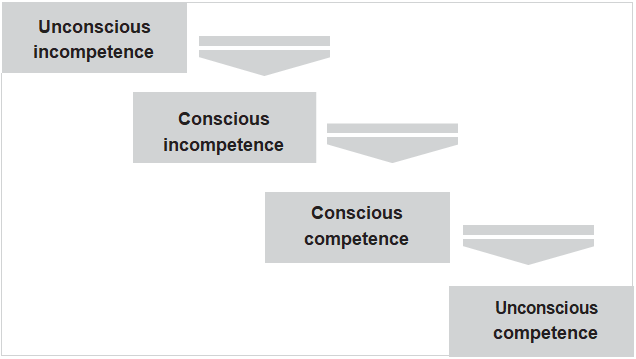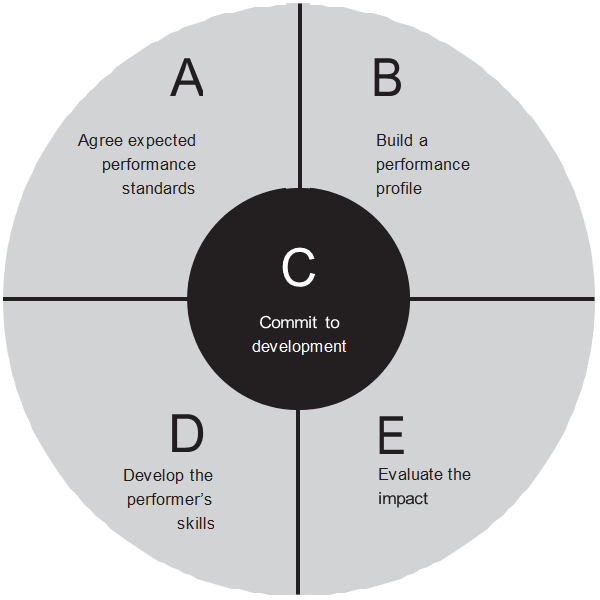Chapter 7
Step D of Procoach:
Develop The Performer’s Skills
D: Develop the performer’s skills Key
Key chapter points
- This step concerns addressing a performance gap for skill or knowledge issues
- Skill coaching should reflect the needs of the coachee, rather than your style of coaching
- You can address a skill gap during a coaching conversation in which you identify a need, or you may do this on a subsequent occasion.
- Skills or knowledge development can be undertaken with an individual or a small group
People learn new skills & knowledge in different ways
As you will have gathered by now, as a coach you need to be adaptable, matching your approach to the needs of your coachee.
Step D of the Procoach A-E model is concerned with addressing the performance gaps and coachee potential identified during Step C, the coaching conversation.
As with previous steps, a coach needs to take into account the needs of their coachee, in learning or enhancing a skill. Be aware when developing skills that different people learn in different ways. This means that as a coach you may need to adapt your style. Your aim is to use an approach that will help your coachee become confident and capable in the skill area.
Consider different people in your team. How do you and they learn? Perhaps one of these descriptions fits:
Get stuck into the action!
These people love role-plays and
“having a go for real”.


Think and take it slower
These people ask to prepare or want
to look at some examples first.
Why is Step D important?
For performance coaching in a business environment, we regard it as essential that a manager can provide ongoing skills practice and feedback in areas where they might reasonably be expected to have some expertise. This is the “What to coach”.
This is why we regard Step D as an essential element of effective coaching. We provide guidance through our Procoach programme about the elements that make up successful skill coaching. We often find other performance coaching models do not address this step.
In addition to a manager having an intimate knowledge of how their team operates and how to apply skills, there is another benefit to the manager as a coach, providing skill development during Step D.
This benefit relates to the way in which we learn*

*Based on Learning Stages model, Gordon Training International
When learning a new skill, everyone passes through four stages of development, shown above. We progressively become more adept at a skill by constantly reinforcing the use of that skill, through application and receiving feedback.
A manager is available far more often than say a classroom facilitator. They can therefore provide ongoing motivation to continue to apply a newly learnt skill. And they can give constructive feedback about how their team member is applying the skill. This allows the coachee to continuously adapt their application of a skill, until they become unconsciously competent, in other words, they carry out the skill without conscious consideration of their actions.
Where does Step D fit into the Procoach A-E model?
Although this model represents five distinct stages of performance coaching, when you become adept at coaching (i.e. moving towards unconscious competence) you will begin to apply this model more flexibly.
As a coaching novice, it is helpful to learn and apply each step as a distinct stage. You can then begin to apply the steps in a more fluid way, responding as appropriate to coachee’s needs.
Procoach A-E model

One method of introducing flexibility early in the process of becoming a better coach is to consider how you are using Steps C and D. In some situations, you might find it better to carry out both Steps C and D in a single session, allowing them to overlap.
For example, a team member might approach you to quickly address a specific development gap.
Following an impromptu conversation (Step C), you might identify an area in which you can provide immediate skill development. Provided both you and the coachee have agreed what development is required and you are prepared to provide the development, you can undertake skill development (Step D) immediately.

You can then conclude the session once you have achieved the objective. If there are other potential performance gaps and potential that you or the coachee wishes to explore, you could revert to the coaching conversation.
You might also find that for some performance gaps, you do not need to provide skills development. For example, your coachee may have been experiencing a lack of motivation. You would discuss and resolve this with them during Step C. If this is the only reason for their performance gap, there would be no need for skills development.
Step C, then D |
|---|
This might happen in a single session or separate sessions, depending on what is suitable.(e.g. Step D might need some preparation) |
Step C, but no D |
|---|
You might decide the coachee does not need developmental help or that you cannot provide it personally at that time. |
Step C diverting briefly into D |
|---|
You might decide to validate whether a skill or knowledge gap actually exists. |
Your coaching options
As we mentioned in the last section, when discussing your plans for skill coaching you can provide different types of development opportunity.
One-to-one and small group sessions are both useful practice methods.
You can also ask a team member or someone outside the team to run a short development session.
Consider online skill development
There are many online resources such as discussion groups, blogs, videos and white papers available too.
Case Study
David considers a recent impromptu coaching session with Emma:
David had just concluded a coaching session with Emma.
It had started as a result of an informal chat when Emma had met David in the corridor. David could tell something was bothering her. When prompted she explained that she was about to make her first presentation to their department and she was nervous.
David suggested they spend a few minutes talking it through. This gave him the opportunity to find out what it was about the presentation that concerned Emma. She explained that she struggled to keep presentations snappy.
She often lost her audience as a result. She wanted to make a good first impression, not bore them!
David checked Emma’s knowledge of presentation structures and they concluded that her knowledge was good and that a bit of practice might calm her nerves and help her deliver a great presentation. David suggested that Emma bring along the presentation she had prepared so that she could practice with David and he could help her to improve any areas they identified.
Emma and David arranged to meet later that afternoon.
Chapter check
What have you learnt from this chapter?
Check your knowledge by answering these questions:
Self-assessment questions
- What different options are available to provide skills development?
- How can you use Steps C and D flexibly to suit the coaching need?
Chapter 7 – Summary & Actions
In this chapter we suggested that:
- This step concerns addressing a performance gap for an ability or skill
- Skill development should reflect the needs of the coachee, rather than your style of
- You may coach to address a skill gap during the session in which you identified the need, or you may do this on a separate occasion.
- Development sessions can be for an individual or a small
Your action plan
Consider the actions you will take to encourage performance improvement in your team, department or organisation.
Ask yourself:
- How do you currently coach? Is it in a style that will be most beneficial to your coachee?
- What opportunities do you take to coach in-the-moment? Is this always appropriate? How can you judge this?
- What development sessions have you carried out for an individual, that would benefit your team?
Make a note of any aspects you feel could improve. Then plan how to make a start on the areas you’ve identified.
